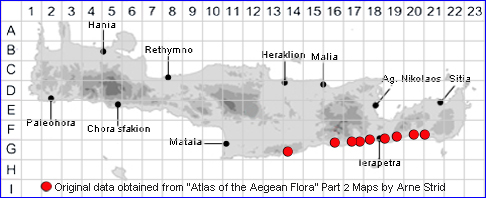
SPECIES DESCRIPTION
LIMONIUM HIERAPETRAE
Family:- PLUMBAGINACEAE
Common Names:- None
Synonyms:- None
Meaning:- Limonium (Gr) Meadow-plant. A name used by the Greek physician
and botanist Dioscorides.
Hierapetrae (L) Possibly meaning its geographical location i.e
Ierapetra, Crete.
General description:- Perennial shrub with numerous stems growing in tight
groups.
Stems :- Erect 20-80 cm.
Leaves:-
a) Lower pale green.
b) hairless.
c) In a rosette.
d) Red-brown at the base..
Flowers:-
1) Small closely aggregated into, dense, crowded, terminal inflorescences.
2) Petals pale blue to violet
a) Forming a tube, exceeding only the upper limb by the surrounded bracts.
Habitat:- On maritime sand and calcareous conglomerate. 0-5 m.
Distribution:- Cretan endemic. Southern coast from Tsoutsouros to Goudouras
Flowering time:- Apr-May, and perhaps also later.
Photos by:- Steve Lenton
FAMILY AND GENUS DESCRIPTIONS
PLUMBAGINACEAE
General description:- Herbs or shrubs.
Leaves:- Alternate or in basal rosettes, exstipulate.
Flowers:- Inflorescence usually cymose, often contracted into a capitulum, rarely
spike-like. Flowers actinomorphic, 5-merous, usually in bracteate spikelets. Calyx
tubular below, toothed (dentate) or lobed and at least slightly thin and dry (scarious)
and often pleated (plicate) distally, persistent. Petals united (connate) only at the
base, or the corolla with a usually short tube. Stamens united with the petals
(epipetalous). Styles 5, or 1 with 5 stigma-lobes. Ovary superior, 1-locular.
Fruit:- Dry, membranous, 1-seeded, surrounded by calyx, not splitting open to
release their seeds (indehiscent) or with circumscissile or irregular dehiscence.
LIMONIUM
General description:- Perennial, rarely annual, herbs or dwarf shrubs.
Leaves:- Simple, usually in a basal rosette, but densely leafy branches sometimes
present; leaves often absent at anthesis.
Flowers:- Inflorescence a corymbose panicle, with terminal, secund spikes, often
with non-flowering branches, usually with a reddish scale at the base of each
branch. Spikes of 3-bracteate, 1- to 5-flowered spikelets; inner and outer bracts
external to the spikelet, the middle one internal and often inconspicuous. Calyx
funnel-shaped (infundibuliform); limb thin and dry (scarious), usually coloured,
sometimes shortly dentate between the lobes. Corolla with a short tube, or the
petals united (connate) only at the base. Stamens inserted at the base of the
corolla. Styles 5, glabrous, free or connate at the base; stigmas thread-like
(filiform).
Fruit:- With circumscissile (opening by a slit running around the circumference) or
irregular splitting open to release the seeds (dehiscence).
1) Calyx infundibuliform.
2) Stamens inserted in base of corolla.
3) Styles 5, free or connate in basal half.
4) Fruit circumscissile towards apex or with irregular dehiscence.
5) Corolla-tube much shorter than lobes.
6) Spikes secund, the terminal not distinctly larger.
7) Stigmas filiform.
Status:-
Conservation status (for threatened species): Vulnerable (V) according to IUCN
1997

LIMONIUM CRETICUM
Synonyms:- None
Meaning:- Creticum (L) From Crete, Cretan.
Resembling Limonium hierapetrae, but differering in the following characters:
1) Stems ascending;
2) Leaf blade abruptly narrowed into the petiole.
3) Greyish-green.
4) Scabridulous,
5) 1-veined.
6) Spikes arcuate, lax.
7) Bracts and calyces somewhat longer.
Click here for a more detailed description of this species.
Habitat:- Coastal habitats with limestone rocks and yellowish marl, 0-10 m.
Distribution:- Restricted to Crete, where it grows in the northwest coast between Chania and Cap Drapano, and in the central-southern part between Timbaki and Kali Limenes
Flowering time:- Late April to July, perhaps also later.
Photos currently unavailable
Synonyms:- None
Meaning:- Creticum (L) From Crete, Cretan.
Resembling Limonium hierapetrae, but differering in the following characters:
1) Stems ascending;
2) Leaf blade abruptly narrowed into the petiole.
3) Greyish-green.
4) Scabridulous,
5) 1-veined.
6) Spikes arcuate, lax.
7) Bracts and calyces somewhat longer.
Click here for a more detailed description of this species.
Habitat:- Coastal habitats with limestone rocks and yellowish marl, 0-10 m.
Distribution:- Restricted to Crete, where it grows in the northwest coast between Chania and Cap Drapano, and in the central-southern part between Timbaki and Kali Limenes
Flowering time:- Late April to July, perhaps also later.
Photos currently unavailable
